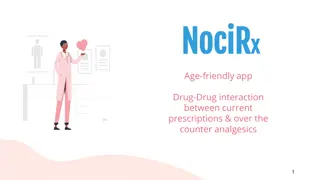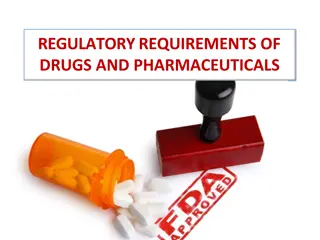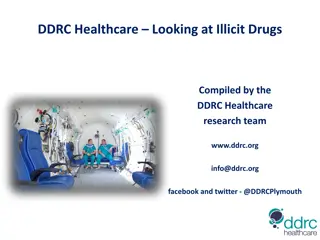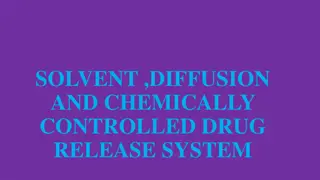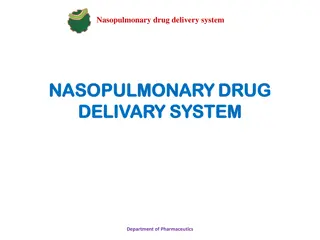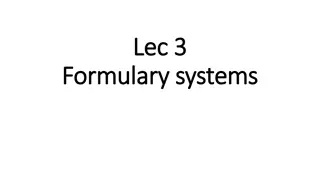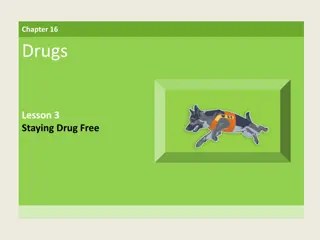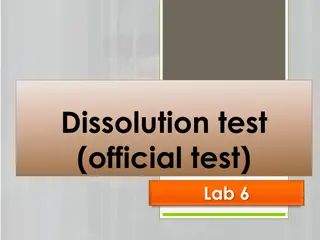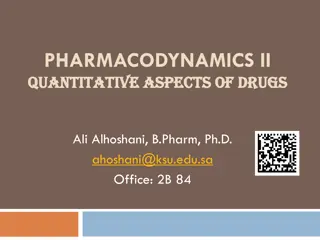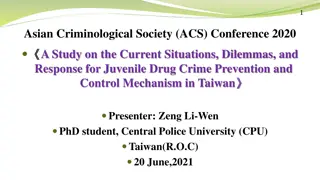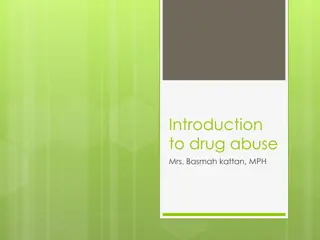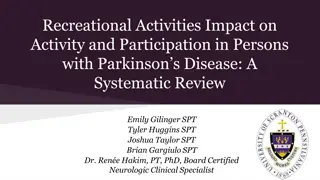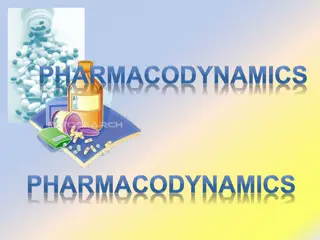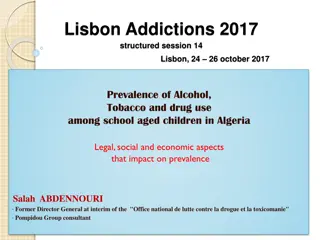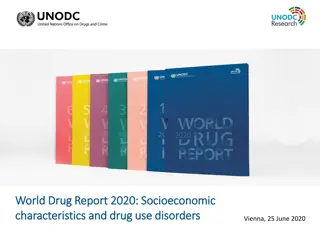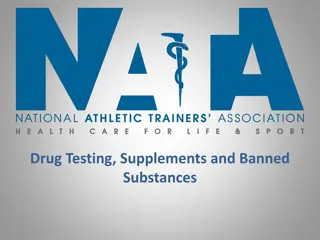Current Trends in Recreational Drug Use: Insights and Implications
The trends in recreational drug use have evolved over time, with a shift towards Novel Psychoactive Substances (NPS) such as Synthetic Cannabinoids, Designer Stimulants, and Designer Opioids. Marijuana remains a focal point, now legal in some states for both medicinal and recreational purposes. The increasing potency of marijuana, advancements in extraction methods like dabbing, and the different types of cannabinoids play significant roles in drug testing challenges. Understanding the effects and mechanisms of cannabinoids, including CB1 and CB2 receptors, is vital for both forensic and clinical laboratories.
Download Presentation

Please find below an Image/Link to download the presentation.
The content on the website is provided AS IS for your information and personal use only. It may not be sold, licensed, or shared on other websites without obtaining consent from the author. Download presentation by click this link. If you encounter any issues during the download, it is possible that the publisher has removed the file from their server.
E N D
Presentation Transcript
Current Recreational Drug Use Trends Presented by Aperian Laboratory Solutions A service of East Alabama Medical Center
Historical review - how we got to where we are now. The classically abused stimulants have included Amphetamine, Methamphetamine and Cocaine. Additionally, marijuana and illicit use of legitimate prescription drugs have also posed significant burdens on the forensic community. Now labs must cope with what has been termed Novel Pyschoactive Substances (NPS) in which there are several pharmacological classes: sedatives/tranquilizers, hallucinogens, dissociative agents, stimulants and analgesics. Most prevalent today, however, are three widely abused NPS: Synthetic Cannabinoids, Designer Stimulants and Designer Opioids
Historical review - how we got to where we are now, cont. Alexander and Ann Shulgin 1960 s and 1970 s Published PiHKAL Illicit phenethylamines (e.g. MDMA) Excerpt on MDMA Piperazine Derivatives (1990 s) Benzylpiperazines Phenylpiperazines Synthetic Cannabinoids, Designer Stimulants and Opioids (2010- present)
Drug Trends Marijuana /Synthetic Cannabinoids (Spice/K2) Designer Stimulants Designer Opioids Kratom
Marijuana Update Still remains a gate-way drug to addiction. Now deemed legal in several states both medicinally and now recreationally in some. Florida s recent legitimizing medicinal marijuana could create additional challenges for interpretation of results both in forensic and clinical labs (e.g. for pain management) performing drug testing. Dabbing is a relatively new method of use either acquiring oil extracts on-line or manually extracting marijuana to use in e-cigarettes. Increases potency due to concentration Allows for less detectable use via lack of smell
Cannabinoids Cannabinoids including endocannabinoids (naturally occurring), phytocannabinoids (cannabis plant), and synthetic cannabinoids (SC). All forms are active at 2 cannabinoid receptors (CB1 and CB2) . CB1 found throughout body with greatest concentration in brain and neuronal tissue. CB2 primarily in immune cells.
Cannabinoids, cont. Beneficial effects of CB1 activation Analgesia (Chronic Pain) Anti-emesis/Anti-nausea(Cancer treatment) Appetite Stimulation (Wasting syndrome) Reduce intra-ocular pressure (Glaucoma) Anti-Spasmotic (Multiple Sclerosis) THC (marijuana) is partial agonist - does not fully activate CB1 receptor In contrast, SC are generally full agonists, i.e. fully activating CB1 receptor.
Synthetic Cannabinoids - History Based on these potential benefits, pharmaceutical companies tried to develop CB1 receptor agonists with greater selectivity/potency. Thus Synthetic Cannabinoids (SC) emerged! Illicit manufacturing of SC took advantage of pre- existing developed compounds but continually modified them to navigate legal issues.
Synthetic Cannabinoids cont. Adverse Effects of SC use Euphoria/Dysphoria (lack of satisfaction) Memory problems Impaired psychomotor performance Increased appetite Recall, SC are generally full agonists to CB1 receptors therefore their effects are pronounced compared to the THC in marijuana.
Synthetic Cannabinoids cont. Additional considerations: Generally, SC are not single compounds when available as powders/liquids. Most abused SC products are often comprised of multiple active compounds. Each compound has a different potency and pharmacological/toxicological effect SC compounds are typically much more potent than THC derived from the cannabis plant. Now seeing increase in serious side effects: For example -Acute kidney injury (AKI) has been reported with some of the newer SC on market (UR-144 and XLR-11).
Synthetic Cannabinoids cont. Legal Status: Control of SC began in Europe in 2009 Problematic in U.S. 12-24 months is the general life-cycle for these compounds Legislative action takes long, therefore there becomes a lag between appearance of drug and meaningful control DEA has used emergency scheduling as a temporary fix. Has also used Federal Analog Act 1986, but wording includes structures that are substantially similar which has proven to be open to debate.
Synthetic Cannabinoids cont. Chemistry and Associated Challenges Chemistry is varied As they are regulated, modifications of the existing compounds are made or entirely new classes are developed in order to circumvent regulations. Often these compounds appear before reference compounds are available to laboratories therefore labs are unable to validate methods for their detection. Toxicological studies are few and mainly on animals. Adverse effects are, in some cases, anecdotal from ED observations.
Synthetic Cannabinoids Representative Changes in scope 2010-2017 2010 (4) JWH-018 JWH-073 JWH-019 JWH-250 2011 (12) AM-2201 AM-694 JWH-019 JWH-018 JWH-073 JWH-081 JWH-122 JWH-200 JWH-210 JWH-250 RCS-4 RCS-8 2012 (20) AM-2201, AM-694, JWH-019, AM-2233 JWH-018, AM-1248 JWH-073, A-796260 JWH-081 JWH-122 JWH-200 JWH-210 JWH-250 RCS-4 RCS-8 JWH-203 JWH-022 JWH-018 CL-analog 2017 (28) AM-2201, UR-144 AM-694, XLR-11 JWH-019, AM-2233 JWH-018, AM-1248 JWH-073, A-796260 JWH-081, FUB-AMB JWH-122, AB-FUBINACA JWH-200, AB-PINACA JWH-210, AB-CHMINACA JWH-250, ADBICA RCS-4, ADB-PINACA RCS-8, AKB-48 JWH-203, 5-Fluoro-PB-22 JWH-022 JWH-018 CL-analog UR-144 XLR-11
Designer Stimulants Cathinones Amphetamine-like compounds originating from Khat plant in Africa White or brown crystalline powder sold in small plastic/foil packages labeled not for human consumption Sometimes marketed on-line as plant food or jewelry cleaner under brand names Ivory White, Bloom Cloud Nine, Lunar Wave, Vanilla Sky and Scarface, etc. Collectively called Bath Salts although nothing to do with typical bath additives
Designer Stimulants, cont. How used? Taken orally, inhaled or injected Most serious outcomes associated with snorting/injecting Compounds commonly encountered: MDPV Mephedrone Methylone Butylone Pentylone -Alpha-PVP (Flakka) -Buphedrone -Ethylone -Naphyrone -4-Methylecathinone
Designer Stimulants, cont. Effects on body? Energizing/Agitating consistent with Amphetamines/Cocaine MDPV shown to raise brain dopamine in same manner as cocaine but is 10x as potent. May cause hallucinations by raising serotonin levels Paranoia, panic attacks, excited delirium Breakdown of muscle tissue Kidney failure Death High addiction potential Seen as substitution for Ecstasy (unknowingly)
Designer Opioids What are they? Typically developed to be structurally similar to legitimate compounds such as non-morphine based semi-synthetic and synthetic opioids; e.g. meperidine, fentanyl, pentazocine, methadone, and tramadol. As with SC s discussed earlier, many of the compounds being encountered today were first synthesized by pharmaceutical companies (in the 1950 s) while attempting to exploit the structure activity relationships of opioid receptors in the CNS. Most were shelved as a result of adverse side affects.
Designer Opioids Fentanyl (Duragesic) Extremely fast acting and potent drug (50-100x more potent than morphine and dosed in mcg vs. mg) Quickly crosses blood-brain barrier. Causes severe respiratory depression and euphoria. Typically dosed as transdermal patches for chronic pain (worn for 48-72 hrs), but also as lozenge, pill, injection, film that dissolves in mouth, nasal spray or by IV. Abuse includes extracting drugs from transdermal patches and injecting which increases likelihood of overdose. Recent seizure in Ohio (1Kg) and it s lethal potential.
Clandestine Fentanyl Analogs Mass-produced in clandestine labs in China and smuggled via traditional distribution routes directly or indirectly into US. Acetyl Fentanyl 5-15x more potent than Morphine Butyryl Fentanyl 12-25x more potent than morphine Furanyl Fentanyl 10-20x more potent than morphine U47700 (Pink) 7.5x more potent than morphine Carfentanil (large animal tranquilizer) 10,000x more potent than morphine
Clandestine Fentanyl Analogs, cont. Others now being encountered: Acryl Fentanyl May not respond to naloxone Tetrahydrofuran Fentanyl Thiafentanil May be replacement for Carfentanil in veterinary practices. Grey Death and Clandestine Pharmaceuticals Being Seen - Grey Death: a deadly combination of heroin or cocaine with one or more fentanyl analogs. Seen in GA, AL, OH. - Spiked Pharmaceuticals: Counterfeit pharmaceutical (lookalikes) are being seen that are spiked with these same compounds.
Kratom Derived from leaves of Kratom tree (Mitragyna speciosa) contains two active ingredients, Mitragynine and 7- hydroxymitragynine. Typically sold as capsules or pressed tablets from leaf material or as a concentrated extract resembling small energy drink containers. Most use is by ingestion In the southeast, it is illegal in AL and TN, but available in neighboring states (GA, FL and MS) at convenience stores or on-line. At low doses (1-5 grams)it is a stimulant, at higher doses (5- 15 grams) it creates lethargy, analgesia and euphoria.
Kratom Mitragynine provides majority of pain relieving action and has been determined to be approximately 13x more potent than morphine. All effects are dose-dependent and occur rapidly. Doses exceeding 15 g can lead to a state of excessive sedation or stupor. Some instances have been reported where Kratom products have been mixed with other narcotics to enhance the narcotic effect making them more dangerous to the na ve user.
Testing Techniques used in Forensic/Clinical Reference Labs Pre-Immunoassay Limited by lack of computer processing speed TLC GC and LC with various specific detectors (e.g. FID, NPD, ECD) Only acquire or process data-not simultaneously Immunoassays due to commercial production of Antibody- Antigen reagents coupled with chromophore for colorimetric detection indicates if drug or drug class is present at or above a cutoff established by lab or commercial reagent kit. Cannot provide a definitive identification of which drug or drug metabolites are present. Methodology is used both with current in-home kits (e.g. rapid cups) as well as lab instrumentation. Must understand limitations (false positives/negatives)
Testing Techniques used in Forensic/Clinical Reference Labs Confirmation definitively identifies substance(s) and whether above a cutoff when applicable. Two prominent examples: 1.) Gas Chromatography/Mass Spectrometry (GC/MS) Drug needs to be volatilized by injecting into heated injection port. Many drugs require derivatization to analyze Lengthy run time Cost - 70-100K each
Testing Techniques used in Forensic/Clinical Reference Labs 2.) Liquid Chromatography/Tandem Mass Spectrometry - have become much more prevalent in last 5-10 years Operates at ambient temperatures with very short run times No derivatization required Excellent resolution of compounds, increase in sensitivity enables very low sample volumes (sub-ng/mL) Cost 400K each Presence in clinical labs increasing.
Thank You Presented by Aperian Laboratory Solutions at East Alabama Medical Center
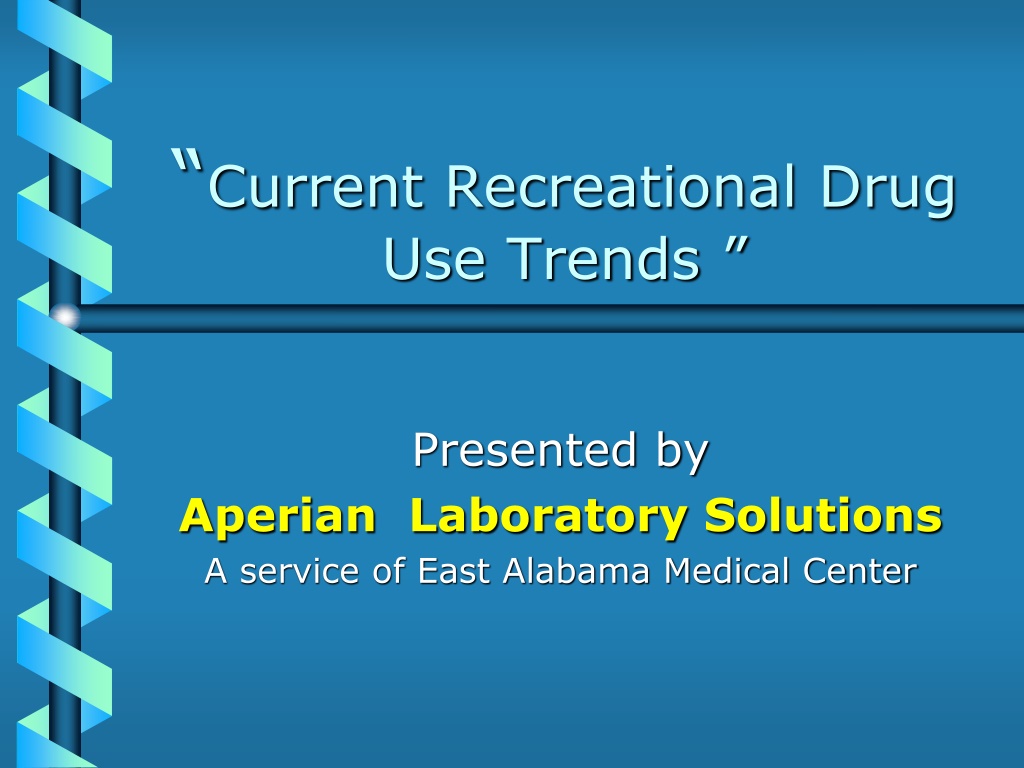
 undefined
undefined







